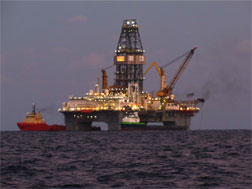On Anniversary of Deepwater Horizon Spill, Bird Conservation Group Calls on BP to Install Bird-Friendly Lighting on Gulf Oil Platforms
 |
| Gulf oil drilling platform by NOAA |
(Washington, D.C.,
“On the anniversary of the Deepwater Horizon spill, we are asking BP to exercise some environmental leadership and make some very simple changes in the lighting on its platforms. Studies have shown that if all the platforms in the Gulf were to make these changes, we would see dramatic reductions in the bird fatalities caused by lights,” said Dr. Michael Fry, Director of Conservation Advocacy for ABC, the nation’s leading bird conservation group.
White lights on oil and gas platforms cause an estimated 200,000 bird deaths per year. Migrating songbirds are drawn to the light, and, once captured in the glare, become disoriented. Some birds circle in confusion before crashing into the platform or falling from the sky, exhausted. Others land on the platform where there is no food or drinking water. Some of these birds continue on quickly, but many stay for hours or even days. When finally able to leave, they can be in a weakened state and unable to make landfall or more are more vulnerable to predation.
“We are talking about simple fixes to existing platform lighting. We need to replace both white and red lights with commercially available green lights; shield the lights from above; and reduce the duration of nighttime lighting during bird migration periods. Safety concerns can be managed within the framework of these changes,” Fry said.
This would be a low cost solution to protect birds in the Gulf, and would partly compensate for bird deaths from the BP oil spill one year ago. Birds suffered tremendously as a result of the Gulf spill. Installing bird-friendly lighting on their platforms is one simple action BP could take that would have a tangible, positive impact for birds,” he said.
While there have been numerous studies on this issue, the study most often cited is a 2007 report by F.J.T. Van De Laar on oil and gas platform lighting impacts to birds in the North Sea. The report indicated that standard white lighting attracted birds and the report demonstrated that changes in to green lights on the platforms would result in a minimum reduction of impact (to birds) by 50%, with a possible reduction of 90%. Another study, in 2005 indicated that about 200,000 birds were killed in the Gulf of Mexico as a result of bird adverse oil and gas platform lighting.
There are approximately 6,000 oil and gas platforms in the Gulf of Mexico. Other countries, such as the Netherlands have instituted bird friendly lighting on oil and gas platforms off their coast.
Dr. Fry currently serves as the Chairman of the Bureau of Ocean Energy Management Scientific Advisory Committee for Environmental Studies.


















































